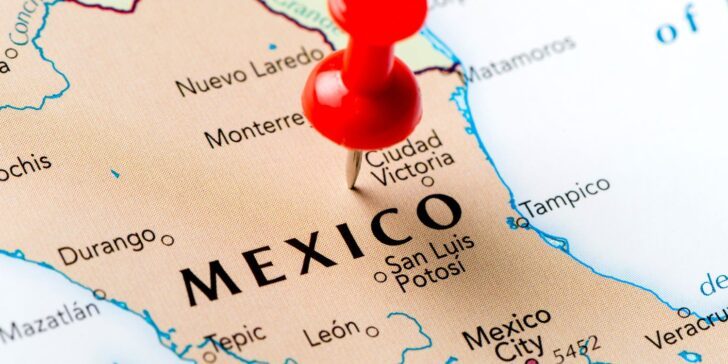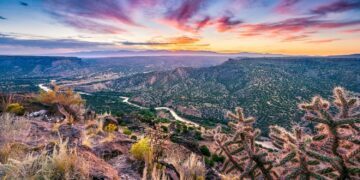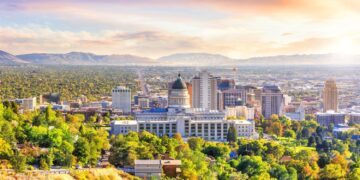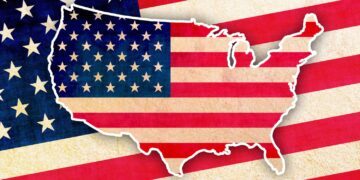Mexico is a country bursting with rich heritage, lively festivals, breathtaking beaches, and downright delicious food.
It’s no surprise that it tops the bucket lists of many travel enthusiasts!
But there’s so much more to Mexico than meets the eye.
Did you know it’s the site of the impact of the asteroid that wiped out the dinosaurs? Or that it’s a land filled with fascinating superstitions?
So, pack your bags and get ready to dive into a world of wonder as we explore the many captivating aspects of Mexico!
The symbol in Mexico’s flag is based on the Aztec legend in which the gods told the Aztecs that the ideal place to build their city was where they found an eagle perched on a cactus, devouring a snake.
From 2017 to 2023, Mexico consistently produced more than 2.2 million tons (2 million metric tonnes) of avocados, making it the top producer worldwide!
A whopping 5,000 festivals are celebrated annually in Mexico! Some examples include the Vive Latino Festival, Cervatino Festival, and Corona Capital Festival.
The largest pyramid in the world (in terms of base width) is Tlachihualtepetl, the Great Pyramid of Cholula in Mexico. It measures 1,476 by 1,476 feet (450 by 450 meters) at its base and is 217 ft (66 m) tall!
As of 2024, Mexico City is the fifth most populated city in the world, with an estimated population of 21.6 million!
Much of Mexico’s capital, Mexico City, was built on the ruins of Tenochtitlan, the capital of the Aztec Empire.
With over 125 million native speakers, Mexico is the largest Spanish-speaking country in the world.
Certain names are banned in the Mexican state of Sonora to prevent children from being bullied because of their names. What’s on the list? James Bond, Email, Robocop, Batman, and even Hermione!
Mexico ranks as the 13th largest country globally, covering 760,621 square miles (1,972,550 million square kilometers) in area.
Lucha libre is a Mexican professional wrestling style known for its colorful masks and high-flying moves. It’s the second most popular sport in Mexico, right behind soccer.
Mexico’s Independence Day, September 16, doesn’t mark the day the nation gained its independence. Instead, it commemorates the famous 1810 Grito de Dolores (Cry of Dolores) speech that demanded the end of Spanish rule and began the War of Independence.
In 1821, Mexico became a monarchy under Agustín de Iturbide, forming the First Mexican Empire. However, his rule was short-lived, as the nation adopted a republican form of government two years later.
The country’s second and last emperor was Maximilian I, who served from 1864 to 1867 during the Second Mexican Empire. He was appointed after Napoleon III and his French troops defeated the Mexican army.
Mexico was the first country to host the FIFA soccer World Cup twice, with the first in 1970 and the second in 1986.
The earliest cacao plants were discovered in Mesoamerica, particularly among ancient civilizations like the Maya and Aztecs in present-day Mexico.
The Olmecs of Southern Mexico are considered the first to roast and grind cacao plants into chocolate, dating back to 1500 B.C., and they used it for medicinal and ritual purposes.
In 1938, the Mexican government took control of foreign oil companies and created Pemex (or Petróleos Mexicanos) to manage the country’s oil industry.
After Spain colonized Mexico in 1521, new ingredients, such as beef, pork, and cheese, were added to tacos. However, before that, the Mexican delicacy’s filling was mostly beans, fish, and even insects!
One of the most common superstitions in Mexico says that if a rooster crows at night, someone has lost their life.
From 1565 to 1815, Mexico was part of the Manila Galleon Trade Route, where Spanish galleons sailed between Acapulco, Mexico, and Manila, Philippines, exchanging goods like silver and spices across the Pacific Ocean.
The largest bullfighting arena in the world is Plaza de Toros México, located in Mexico City. It has a seating capacity of more than 41,000 spectators!
On July 7, 2007, Mexico’s Chichen Itza archeological site was chosen as one of the Seven New Wonders of the World.
Texas was once a part of Mexico until the dramatic Texas Revolution of 1836. Shortly after, in 1845, it joined the United States.
With 164 champions, Mexico has the second-highest number of world boxing champions. Notable champions include Julio César Chávez and Canelo Álvarez.
In 2010, a major environmental disaster, the Deepwater Horizon oil spill, occurred in the Gulf of Mexico. Of the 205.8 million gallons of oil spilled, only around 51 million gallons were recovered, with the rest permanently affecting local ecosystems.
According to historians, Mexico got its name from the Mexica (also known as the Aztecs), Nahuatl-speaking people who settled in the Valley of Mexico.
However, legend has it that Mexico’s name was derived from the Nahuatl words mētztli (moon) and xīctli (navel), thereby referring to Mexico as the “Place at the Center of the Moon.”
In 2023, Mexico produced 1.9 million barrels of oil daily and was ranked the 11th largest oil producer by the US Energy Information Administration.
Mexico’s capital city, once known as Distrito Federal, underwent a significant change when Mexican President Nieto signed a law in 2016 officially renaming it Ciudad de Mexico (Mexico City).
Until the Treaty of Guadalupe was signed on February 2, 1848, California, Utah, and New Mexico were all part of Mexican territory.
The largest of the 32 Mexican states is Chihuahua, with an area of 95,526.5 square miles (247,412.6 square kilometers).
The Mexican state of Chihuahua is home to the Copper Canyon. While larger than the Grand Canyon, it’s made up of many smaller canyons rather than just one large one.
In Mexican tradition, eating bolillo bread is a common practice when feeling stressed or scared. Bolillos are long, oval-shaped breads that are crunchy on the outside and soft on the inside!
Nopal pads, a part of the cactus, are a common ingredient in Mexican cuisine. They can be used in soups, stews, and salads, but you can also eat them raw!
Sweeping at night is a big no-no in Mexico, as it’s believed to bring bad luck to one’s home.
Cancún, Mexico, has an underwater museum featuring 500 mesmerizing sculptures! It opened in 2010 and was created to protect local coral reefs by providing an alternative site for divers.
Ox Bel Ha System, in Tulum, Mexico, is 270.8 miles (435.8 km) long and is considered the longest underwater cave system in the world.
Mexico is one of the countries with the most UNESCO World Heritage Sites, with 35 heritage sites as of 2024. Aside from Chichen Itza, other notable examples are Sian Ka’an Biosphere Reserve, El Tajin, and Teotihuacan.
It’s customary for Mexicans to tocar madera (“knock on wood”) right after making a statement or prediction to prevent jinxing themselves!
The name for sombreros, wide-brimmed hats typically measuring up to 2 feet (61 centimeters), comes from the Spanish word sombra, meaning shade.
Donald Trump tried to make Mexico pay for the construction of a wall between it and the US. Mexico rejected the suggestion, and the small parts of the wall that were actually built were 100% US-funded.
In Mexico City, there’s an island filled with spooky dolls called Isla de las Munecas (The Island of the Dolls). It was created in the 1950s but didn’t open to the public until 2001.
In 2023, Mexico ranked as the world’s second-largest consumer of Coca-Cola, right behind the US, drinking a staggering 5,151 million gallons (19,500 million liters) annually!
Spain introduced piñatas to Mexico during the 16th century. However, as it turns out, the Mayans and Aztecs of Ancient Mexico already practiced a similar tradition prior to this.
In 2008, Mexico banned smoking in bars, restaurants, and workplaces. Further restrictions, banning smoking and tobacco advertising in all public areas, were introduced in 2021.
Mexico City’s metro system has reserved subway cars for each line for women and children since 1970, just one year after the subway opened.
The Chicxulub asteroid, which is believed to have caused the dinosaur extinction event, hit Mexico’s Yucatán Peninsula 66 million years ago. Sadly, the crater is now buried, but the area’s numerous cenotes (or sinkholes) confirm the impact site.
According to the 2020 census, 91.3% of Mexicans are Christian, with 77.8% identifying as Catholic.
Cuexcomate, often incorrectly labeled the world’s smallest volcano, is actually an inactive geyser. Located in Mexico’s Puebla city, it stands only 43 feet (13 m) tall.
Mexico is home to one of the world’s few pink lakes. It’s located in Las Colaradas, Yucatan, and it gets its distinctive hue due to organisms that thrive in salty water and produce beta-carotene, a compound that gives off a red-orange pigment.
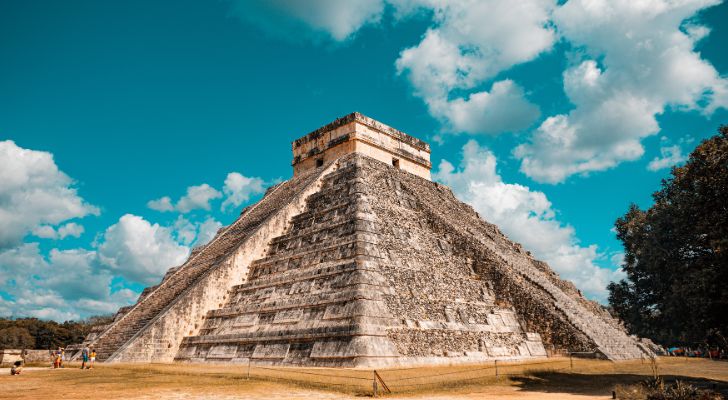
There are countless reasons why Mexico is worth visiting. You can immerse yourself in a variety of cultures and explore places filled with spectacular stories.
Whether visiting Chichen Itza or the Great Pyramid of Cholula, you’re sure to leave with countless unforgettable memories.
If you’re looking for a sign to make Mexico your next travel destination, this is it!

